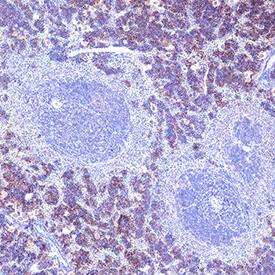Mouse IL-4 Antibody
R&D Systems, part of Bio-Techne | Catalog # MAB4041

Key Product Details
Species Reactivity
Applications
Label
Antibody Source
Product Specifications
Immunogen
His23-Ser140
Accession # P07750
Specificity
Clonality
Host
Isotype
Scientific Data Images for Mouse IL-4 Antibody
Detection of IL-4 in Mouse Spleen.
IL-4 was detected in immersion fixed paraffin-embedded sections of Mouse Spleen using Rat Anti-Mouse IL-4 Monoclonal Antibody (Catalog # MAB4041) at 5 µg/mL for 1 hour at room temperature followed by incubation with the Anti-Mouse IgG VisUCyte™ HRP Polymer Antibody (Catalog # VC001). Before incubation with the primary antibody, tissue was subjected to heat-induced epitope retrieval using VisUCyte Antigen Retrieval Reagent-Basic (Catalog # VCTS021). Tissue was stained using DAB (brown) and counterstained with hematoxylin (blue). Specific staining was localized to lymphocytes. View our protocol for IHC Staining with VisUCyte HRP Polymer Detection Reagents.Applications for Mouse IL-4 Antibody
Immunohistochemistry
Sample: Immersion fixed paraffin-embedded sections of Mouse Spleen
Formulation, Preparation, and Storage
Purification
Reconstitution
Formulation
Shipping
Stability & Storage
- 12 months from date of receipt, -20 to -70 °C as supplied.
- 1 month, 2 to 8 °C under sterile conditions after reconstitution.
- 6 months, -20 to -70 °C under sterile conditions after reconstitution.
Background: IL-4
Interleukin-4 (IL-4), also known as B cell-stimulatory factor-1, is a monomeric, approximately 13 kDa-18 kDa Th2 cytokine that shows pleiotropic effects during immune responses (1-4). It is a glycosylated polypeptide that contains three intrachain disulfide bridges and adopts a bundled four alpha-helix structure (5). Mouse IL-4 is synthesized with a 24 aa signal sequence. Mature mouse IL-4 shares 39%, 39%, and 59% aa sequence identity with bovine, human, and rat IL-4, respectively. Human, mouse, and rat IL-4 are species-specific in their activities (6-8). IL-4 exerts its effects through two receptor complexes (9, 10). The type I receptor, which is expressed on hematopoietic cells, is a heterodimer of the ligand binding IL-4 R alpha and the common gamma chain (a shared subunit of the receptors for IL-2, -7, -9, -15, and
-21). The type II receptor on nonhematopoietic cells consists of IL‑4 R alpha and IL‑13 R alpha1. The type II receptor also transduces IL‑13 mediated signals. IL-4 is primarily expressed by Th2‑biased CD4+ T cells, mast cells, basophils, and eosinophils (1, 2). It promotes cell proliferation, survival, and immunoglobulin class switch to IgG1 and IgE in mouse B cells, acquisition of the Th2 phenotype by naïve CD4+ T cells, priming and chemotaxis of mast cells, eosinophils, and basophils, and the proliferation and activation of epithelial cells (11 ‑ 14). IL-4 plays a dominant role in the development of allergic inflammation and asthma (13, 15).
References
- Benczik, M. and S.L. Gaffen (2004) Immunol. Invest. 33:109.
- Chomarat, P. and J. Banchereau (1998) Int. Rev. Immunol. 17:1.
- Lee, F. et al. (1986) Proc. Natl. Acad. Sci. 83:2061.
- Noma, Y. et al. (1986) Nature 319:640.
- Redfield, C. et al. (1991) Biochemistry 30:11029.
- Ramirez, F. et al. (1988) J. Immunol. Meth. 221:141.
- Leitenberg, D. and T.L. Feldbush (1988) Cell. Immunol. 111:451.
- Mosman, T.R. et al. (1987) J. Immunol. 138:1813.
- Mueller, T.D. et al. (2002) Biochim. Biophys. Acta 1592:237.
- Nelms, K. et al. (1999) Annu. Rev. Immunol. 17:701.
- Paludan, S.R. (1998) Scand. J. Immunol. 48:459.
- Corthay, A. (2006) Scand. J. Immunol. 64:93.
- Ryan, J.J. et al. (2007) Crit. Rev. Immunol. 27:15.
- Grone, A. (2002) Vet. Immunol. Immunopathol. 88:1.
- Rosenberg, H.F. et al. (2007) J. Allergy Clin. Immunol. 119:1303.
Long Name
Alternate Names
Entrez Gene IDs
Gene Symbol
UniProt
Additional IL-4 Products
Product Documents for Mouse IL-4 Antibody
Product Specific Notices for Mouse IL-4 Antibody
For research use only
